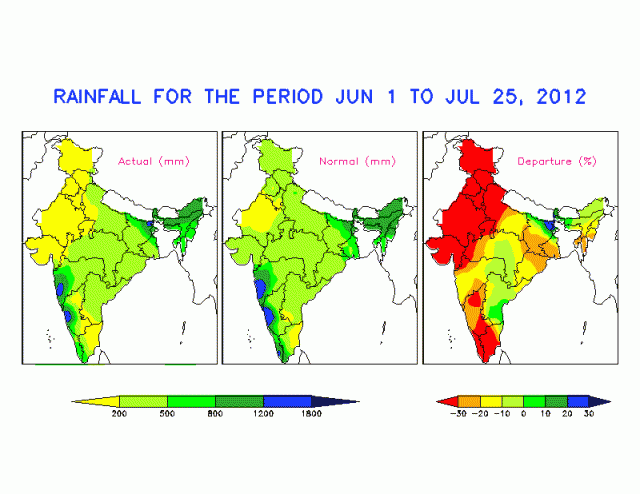27 July 2012
Landslides from the South Asian monsoon in 2012 to date
Posted by Dave Petley
As anyone who has attended one my conference talks knows (see for example the slides here), the global epicentre for landslides that kill people is in South Asia, and in particular the southern edge of the Himalayan mountain chain. The key triggering mechanism is the SW (summer) monsoon, which brings prolonged rainfall throughout this region. The monsoon advance starts in late May, so at this time of year we are now two months into the monsoon period, which is a good time to reflect upon landslide impacts in this year’s monsoon. The graph below show the cumulative number of fatal landslides in South Asia for the last few years. The x-axis is time, shown here as pentads. A pentad is a 5 day period, so Pentad 1 is the period 1st – 5th January, Pentad 2 is 6th to 10th January, etc. The data is taken from Pentad 30 – i.e. day 151 of the year (31st May in case you are wondering) to Pentad 65, which captures the full period of the monsoon:
 The black line is the 2012 data to date. You’ll see that it plots at the bottom of the distribution – i.e. at this stage in the monsoon we have the lowest number of fatality-inducing landslides seen in the last six years. Given the news of extreme weather elsewhere this might come as something of a surprise. However, so far for much of South Asia the SW monsoon has been exceptionally weak. The Indian Institute of Tropical Meteorology maintains a monsoon website, which provides data and maps of the monsoon through the annual cycle. This indicates that across India as a whole monsoon precipitation to date has averaged 295 mm, over 20% lower than the norm at this time of year (382 mm). The map of monsoon rainfall anomalies illustrates this really clearly:
The black line is the 2012 data to date. You’ll see that it plots at the bottom of the distribution – i.e. at this stage in the monsoon we have the lowest number of fatality-inducing landslides seen in the last six years. Given the news of extreme weather elsewhere this might come as something of a surprise. However, so far for much of South Asia the SW monsoon has been exceptionally weak. The Indian Institute of Tropical Meteorology maintains a monsoon website, which provides data and maps of the monsoon through the annual cycle. This indicates that across India as a whole monsoon precipitation to date has averaged 295 mm, over 20% lower than the norm at this time of year (382 mm). The map of monsoon rainfall anomalies illustrates this really clearly:
 Interestingly, the map does suggest that at least eastern Nepal might have received greater than average rainfall, although I have no data to support this. Bhutan on the other hand, which is located just east of Nepal, does appear to have received unusually heavy rainfall so far.
Interestingly, the map does suggest that at least eastern Nepal might have received greater than average rainfall, although I have no data to support this. Bhutan on the other hand, which is located just east of Nepal, does appear to have received unusually heavy rainfall so far.
Of course there is a long way to go in terms of the monsoon this year, and the above graph shows that the last year that started very dry, 2009, ended up with the second highest total on record. It is also worth noting that a very weak monsoon has other impacts too as agriculture across South Asia is critically dependent upon the rainfall that arrives in this period. The Indian government might declare an official drought next week. This might well represent something of a crisis in due course as food prices are expected to increase considerably in the coming months in response to the extraordinary, and rapidly intensifying, drought affecting the USA and Canada.


 Dave Petley is the Vice-Chancellor of the University of Hull in the United Kingdom. His blog provides commentary and analysis of landslide events occurring worldwide, including the landslides themselves, latest research, and conferences and meetings.
Dave Petley is the Vice-Chancellor of the University of Hull in the United Kingdom. His blog provides commentary and analysis of landslide events occurring worldwide, including the landslides themselves, latest research, and conferences and meetings.